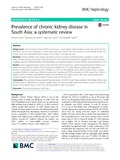| dc.contributor.author | Hasan, Mehedi | |
| dc.contributor.author | Sutradhar, Ipsita | |
| dc.contributor.author | Gupta, Rajat Das | |
| dc.contributor.author | Sarker, Malabika | |
| dc.date.accessioned | 2022-03-10T08:40:12Z | |
| dc.date.available | 2022-03-10T08:40:12Z | |
| dc.date.copyright | 2018 | |
| dc.date.issued | 2018-10-23 | |
| dc.identifier.citation | Hasan, M., Sutradhar, I., Gupta, R. D., & Sarker, M. (2018). Prevalence of chronic kidney disease in south asia: A systematic review 11 medical and health sciences 1103 clinical sciences 11 medical and health sciences 1117 public health and health services. BMC Nephrology, 19(1) doi:10.1186/s12882-018-1072-5 | en_US |
| dc.identifier.uri | http://hdl.handle.net/10361/16442 | |
| dc.description | This article was published in the BMC Nephrology [© The Author(s). 2018 Open Access This article is distributed under the terms of the Creative Commons Attribution 4.0 International License (http://creativecommons.org/licenses/by/4.0/) ] and the definite version is available at: https://doi.org/10.1186/s12884-018-1993-9 The Journal's website is at: https://bmcnephrol.biomedcentral.com/articles/10.1186/s12882-018-1072-5#citeas | en_US |
| dc.description.abstract | Abstract
Background: Chronic kidney disease (CKD) is becoming a major public health problem around the world. But the
prevalence has not been reported in South Asian region as a whole. This study aimed to systematically review the
existing data from population based studies in this region to bridge this gap.
Methods: Articles published and reported prevalence of CKD according to K/DOQI practice guideline in eight South
Asian countries between December 1955 and April 2017 were searched, screened and evaluated from seven electronic
databases using the PRISMA checklist. CKD was defined as creatinine clearance (CrCl) or GFR less than 60 ml/min/1.73 m2
.
Results: Sixteen population-based studies were found from four South Asian countries (India, Bangladesh, Pakistan and
Nepal) that used eGFR to measure CKD. No study was available from Sri Lanka, Maldives, Bhutan and Afghanistan.
Number of participants ranged from 301 in Pakistan to 12,271 in India. Majority of the studies focused solely on urban
population. Different studies used different equations for measuring eGFR. The prevalence of CKD ranged from 10.6% in
Nepal to 23.3% in Pakistan using MDRD equation. This prevalence was higher among older age group people. Equal
number of studies reported high prevalence among male and female each.
Conclusions: This systematic review reported high prevalence of CKD in South Asian countries. The findings of this study
will help pertinent stakeholders to prepare suitable policy and effective public health intervention in order to reduce the
burden of this deadly disease in the most densely populated share of the globe. | en_US |
| dc.language.iso | en_US | en_US |
| dc.publisher | BMC | en_US |
| dc.relation.uri | https://bmcnephrol.biomedcentral.com/articles/10.1186/s12882-018-1072-5#citeas | |
| dc.subject | Chronic kidney disease | en_US |
| dc.subject | South Asia | en_US |
| dc.title | Prevalence of chronic kidney disease in South Asia: A systematic review | en_US |
| dc.type | Journal Article | en_US |
| dc.description.version | Published | |
| dc.contributor.department | Brac James P. Grant School of Public Health | |
| dc.identifier.doi | https://doi.org/10.1186/s12882-018-1072-5 | |
| dc.relation.journal | BMC Nephrology | |

